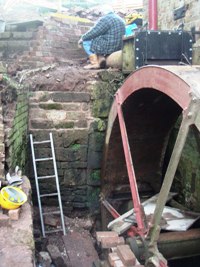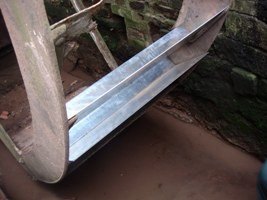A Bricklaying Day

Max worked on the end wall of the water-wheel pit, building up a couple of courses of tufa stone. You can see the new lime mortar above the ladder in the photo. We are all impressed by Max’s work, which is harder to do than ordinary bricklaying because each stone is different. One more course will see this stonework complete.
In the same photo you can see John eyeing up the wall he worked on today. This particular wall is also a bricklaying challenge because the original footings are far from even. John does like to produce nice level courses of tidy brickwork but it just isn’t possible with these old hand-made bricks. A look around the other farm buildings quickly reveals the variation of levels that the old builders found acceptable, and none of the buildings has fallen down yet so it must be OK.
Martyn did some bricklaying along the wall beside the waterwheel. The photo doesn’t do justice to his work because it is all hidden behind his hard hat. All three of these walls are going to meet in the near future. There is going to be a low brick wall on top of the tufa wall that Max has built joining John’s wall with the mill building. John’s wall will then continue its curve and join up with the wall Martyn is building.
While all this was going on Dave also did some bricklaying, the chamber for the PTO shaft in this case. He also had to contend with very uneven footings and some very odd levels but the finished brickwork looks good. When the brickwork is finished we will get some gratings made up to cover this chamber so that the workings will be visible but safely enclosed.
With all this building activity going on Richard was kept busy with the cement mixer. In the course of the day we needed three buckets of lime mortar, three buckets of concrete and twelve buckets of cement mortar.

Just as we were beginning to wind down Colin and Headley arrived with six very shiny new buckets for the waterwheel. They had made these at a factory owned by a friend of Headley and they are supplying the galvanised steel at cost and giving us free use of the machinery. We need thirty buckets in all but it seemed like a good idea to check the first batch for size before making them all.
They drop into place beautifully as you can see in the photo. The next job will be to drill the bolt holes and fix them in place. We have been advised to replace the buckets one at a time to keep the wheel aligned and as the advice came from someone who had dismantled a similar wheel to refurbish it and then wished he hadn’t, we are going to follow it.
All in all we had a good day bricklaying and seeing the new buckets was the icing on the cake. On days like today it is much easier to believe that we might end up with a working mill.
Go to the next entry by clicking here.
Enough about bricklaying? Click here to see the previous article.
Leave the Shelsey Mill Blog and return Home.